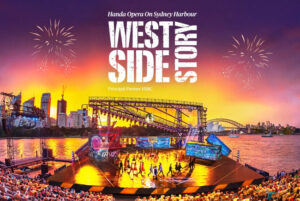
Handa Opera on Sydney Harbour 2024 Review: West Side Story
By Zoltan SzaboHanda Opera on Sydney Harbour, now in its thirteenth year, is a cultural entity in Australia, made possible with the ongoing financial assistance of the Japanese businessman, philanthropist and spiritual leader, the mysterious Dr Haruhisa Handa.
This time in every year (except for 2020, due to COVID cancellations), an enormous stage is erected on the water of Sydney Harbour, while the audience, around 3000 a night, is being seated on the shore. Due to this unique position, the backdrop to the annual spectacle is the Harbour Bridge with Luna Park right behind it, the Sydney Opera House, the beautifully lit downtown area of the city, and at least twice I witnessed a full moon glowing on the star-studded sky on opening nights. Every year, at an opportune moment, fireworks explode above the stage and whenever appropriate, a dramatic moment for a water taxi or a large car (sometimes both!) would be found to make a grand entrance into the narrative and the bemused audiences’ hearts. It would be difficult to find a more spectacular venue for an outdoor opera performance.
Each year one production is given six performances a week, over a month, mostly one of the “top-ten” operas composed by Puccini, Bizet or Verdi. Three of the last five productions were musicals, setting a slightly alarming trend perhaps? While an understandable economic decision, it poses an uncomfortable question. As Opera Australia has the greatest financial government support of all Australian opera companies and enjoys more funding for its annual Sydney Harbour performances, should it not have a mandate to promote opera, rather than musical theatre? As a production company, of course, it can hire the best musical theatre experts to put on shows. However, if it is still primarily an opera company, using such generous fundings, should its first duty be to offer employment to its own opera singers, chorus and orchestra and educate Australian audiences?
This time, it was the return of one of the most operatic of music theatre works, “West Side Story,” for its revival 2019 run, as it remains the most successful of all Handa Opera seasons. Leonard Bernstein’s music and Jerome Robbins’s choreography excel in such synergy that to this day, many productions (particularly in Anglo-Saxon countries) retain both to guarantee success. This was the director, Francesca Zambello’s decision as well, and the accomplished work of revival choreographer, Kiira Schmidt Carper, kept the turf war between the modern-day Montagues and Capulets, all in New York’s West Side, exciting if not spectacular. It aspired but failed to be the latter for the simple reason that on such a massive stage (about three times the size of Opera Australia’s own indoor stage) the rival gangs ran, quarrelled, fought and played in regrettably small numbers. Even at the “Dance at the Gym”, where all the Jets and Sharks meet, there were barely twenty actors/singers on stage (or less than half of what one can see in the brilliant 1961 film of the musical). A decade ago, in “Carmen” on the Harbour, over 150 performers adorned the stage and, as a result, it looked busy and flamboyant. Common sense would suggest that a big stage requires a lot of performers on it – basic stagecraft, right? With tickets priced at an eye-watering $380 on opening night and a program book selling for $30, greater numbers could be expected.
The slight number of performers was particularly noticeable as the production otherwise was lavishly produced with great sets (complete with a heavily graffitied apartment block with the obligatory fire escape, three subway cars and a 1950s drug store, even a bridal shop, the work of set designer Brian Thomson), helpfully colour-coded costumes (Jennifer Irwin), and moody streetlights (Lighting Design: John Rayment). The production were amplified and the resulting sound was relentlessly clear and crisp – apparently, over 200 speakers had been used (Sound Design: Des O’Neill).
The orchestra, under the stage, positioned in a space referred to as the “Underworld”, was invisible, keeping contact with the stage via judiciously placed monitors. Their sound was rounded and stylish. The Musical Director, Guy Simpson, maintained technical precision and an excellent pace; not a mean feat where a direct visual connection cannot be guaranteed.
Zambello’s production was lively, but perhaps, as a revival, did not get as much attention as it should have. The action began with the Jets rushing to the stage from between the derelict subway cars and their energy was as uplifting as their dancing, familiar from the film’s prologue. However, with the same communal-running-to-stage repeated time and time again to introduce new scenes, it quickly lost its freshness and became predictable. Generally though, the gangs’ dance scenes were excellently choreographed and executed. Their female counterparts, most noticeably in “America” lacked the same tight coordination and their diction was less clear. The rapid-fire text is so brilliant here and elsewhere that it was a pity to miss significant chunks of it.
As a possible response to some earlier criticisms for featuring only white protagonists, Opera Australia offered the role of Maria to a First Nation soprano, a Koa, Kuku Yalanji, Wakka Wakka woman, Nina Korbe, who sang, acted and danced beautifully. She certainly looked the part while she sang “I feel pretty”. That scene took place in her upstairs room, while she got ready with three of her friends for her meeting with Tony. The room is almost claustrophobically small, and the four girls moved/danced in the restricted space with great skills, creating not only exciting tension but also, a rare and welcome contrast to the huge stage.
Maria’s star-crossed lover, Tony (Billy Bourchier), sang “Maria” tenderly and with a confident high last note, and coped with the difficult rhythms of “Something’s Coming” much better than Jose Carreras did in the awkward sequence during Bernstein’s own recording. The “Somewhere” duet between the young lovers, in one of the most inspired moments of the production, was touchingly underlined with an almost surreal ballet of five Jet members down on the street. The bridal shop’s pretend-wedding of Tony and Maria, on the other hand, lacked intimacy and looked under-directed on centre stage.
Patrick Whitbread, as Riff, was excellent in keeping the Jets calm – if only there were more of the gang members around him to advise in “Cool”. Later, the fight scene between him and Bernardo (Manuel Stark Santos) looked only superficially choreographed and thus, predictable, rather than gut-wrenching; the chicken-calls teasing, rather than deeply insulting and as a result, Tony’s murder of his lover’s brother did not achieve the desired heart-breaking effect. This was then followed by one of the very few weak moments of the script, where Maria seemed to mourn Bernardo’s death only fleetingly, before forgiving Tony.
Kimberley Hodgson, as Anita, was a dear friend to Maria, even when she reminded her of her duties in the passionate “A Boy Like That”. Her attempted rape by the Jets, which ultimately causes Tony’s death, was a close replica of the original film scene (ironically underscored by some of the “I like to be in America” music) and only just stopped by Doc (Wayne Scott Kermond), who is (street)wiser than the two docile policemen, Officer Krupke (Joe Clements) and Lieutenant Schrank (Scott Irwin).
In our times, when war conflicts stir up deep sentiments in un towards the Ukraine, the Gaza strip and elsewhere on a daily basis, it seemed like a missed opportunity not to take the original stage instructions more literally about the two gangs making peace with each other over Tony’s dead body.



